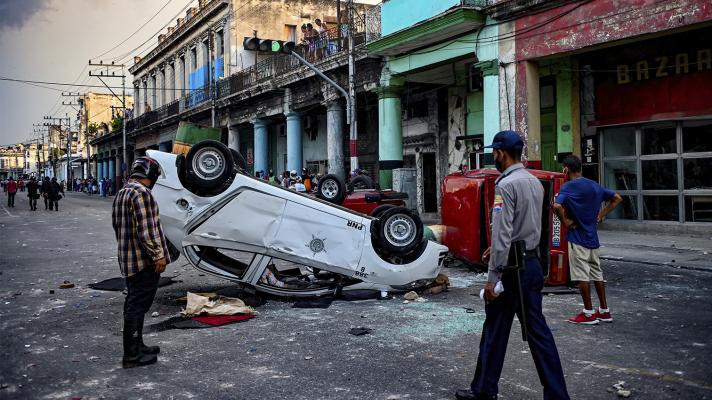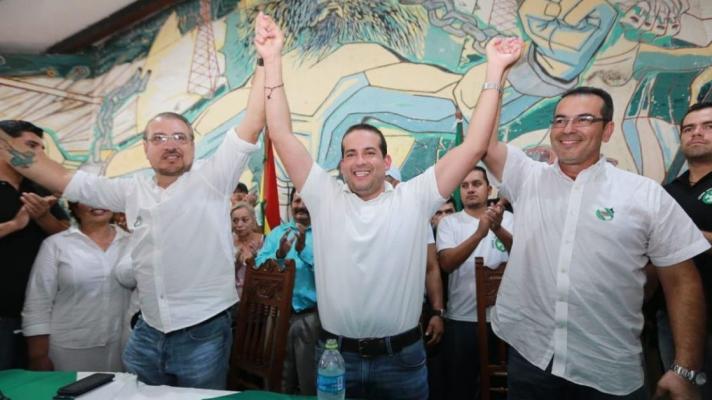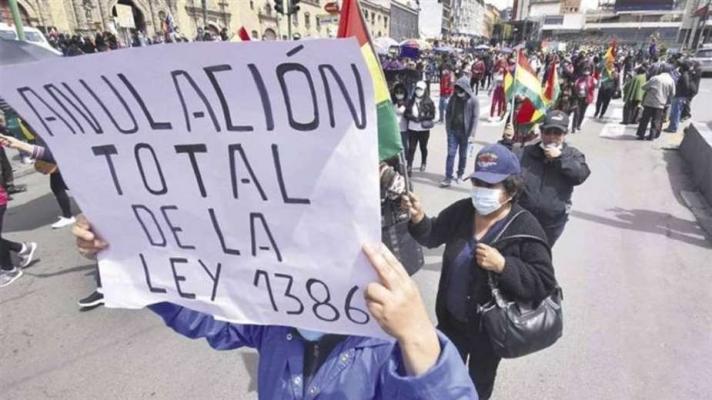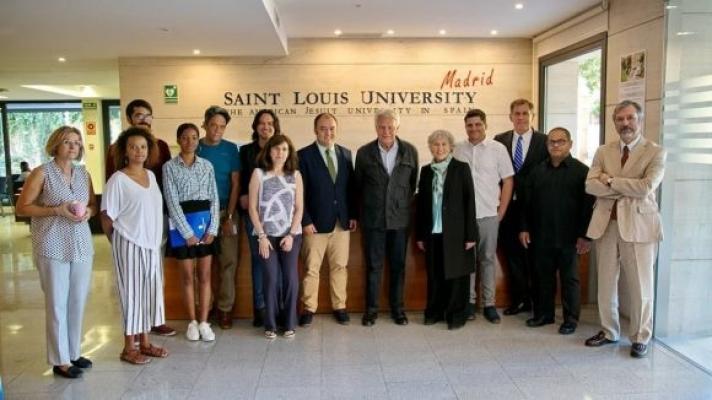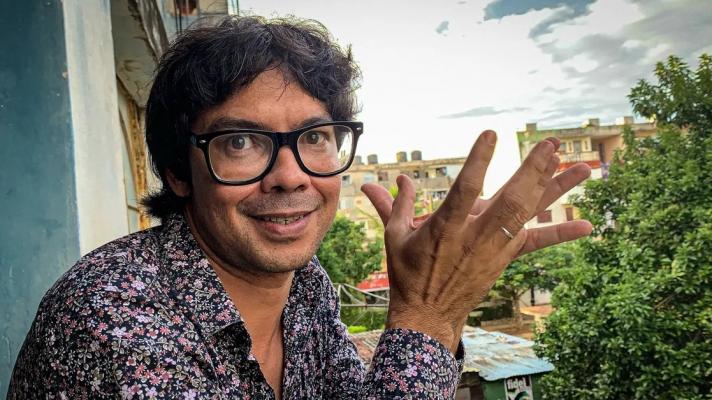The onslaught of the Global North, led by the United States and its battery of unconventional warfare methods, continues to impact the stability of countries that are not aligned with the interests of domestic and transnational elites. Various pretexts and situations are used by internal actors, sponsored by agencies and NGOs exercising soft power, to impose scenes in which chaos and disobedience prevail.
This with the objective that international organizations bring “sanctions” that can provoke military intervention and seek the establishment of an alternative government.
This is a hackneyed script in which media cartels, and now Big Tech, are also key players in a framework in which discontent and distrust in governments and their policies are fostered, in addition to strengthening the morale of the insurgents.
Bolivia and Cuba, with established governments fulfilling their constitutional obligations, are worthy of review and analysis.
CAMACHO, PIVOT OF INTERFERENCE AND THE PERMANENT COUP IN BOLIVIA
An anti-corruption law served as an excuse to destabilize the life of the Bolivian population when opposition sectors called for strikes and protests. It is the already repealed National Strategy Law against the Legitimization of Illicit Gains and Financing of Terrorism (LGI/FT or 1386) proposed by the government of Luis Arce Catacora, president of the Plurinational State of Bolivia, who rejected such mobilizations for being, in his opinion, “pretexts, lies and deceits” stimulated by the environment of the former de facto president Jeanine Áñez and her former ministers.
He was referring to the Minister of the Interior, Arturo Murillo; the Minister of the Presidency, Yerko Núñez; and the Minister of Defense, Luis Fernando López, who are allegedly linked to crimes in the framework of the 2019 coup d’état against the government of then President Evo Morales.
In a meeting with peasants in La Paz, Arce recalled that, at the end of November 2020, the former deputy of the Movement Towards Socialism (MAS), Lidia Patty, denounced the leader of the political group Creemos, Luis Fernando Camacho, and his father José Luis, for alleged crimes of conspiracy, destabilization, terrorism and sedition in the framework of the coup, although their cases have not advanced.
Camacho’s presence in the coup strategy is constant, as it is known that he was at the head of the mobilizations that overthrew Morales together with military and police elites. A month after the coup, a video was unveiled in which Camacho himself acknowledged that his father had made a pact with leaders of the Armed Forces and the Police for that operation. The current governor of the Department of Santa Cruz, a bastion of the opposition, confessed that the pact included a mining leader, who offered him 6,000 miners with dynamite to overthrow Morales after his reelection.
“When we closed with everything and on Saturday, before Evo Morales resigned, the guy says ‘gather all the people, all the civic people at the door of the hotel, I am going to show my face’. Up to that moment he had only talked to me. He already had 6,000 miners full of dynamite to go in and get Evo Morales out,” he said.
According to what he declared, this miner was playing both sides. The morning of that day, Morales called him to ask him to guard the Murillo square because the military had turned their backs on him, as well as the police, and he did not allow the miner to support the former president. He also stressed that his father told him that he was planning the overthrow and promised him that he would become president after Morales.
Camacho’s task has been joined by his successor in the presidency of the Pro Santa Cruz Civic Committee, Rómulo Calvo, who called on the Armed Forces and the Bolivian Police to join “the people”, as his predecessor did. Based on false information they position their “fight” (he said repeatedly that this is his third round or his last opportunity to seek “freedom and democracy”).
They sow doubts about norms that are key for the institutional stability lost during the de facto government of Áñez and justify themselves in rumors in social networks, such as that of an alleged mobilization of troops, in spite of the clarification by the National Army: the Armed Forces are “quartered” to repress the strike of the unionists, which is why they mobilized troops and weapons in the last few days.
It is worth remembering that these same rumors were realities during the de facto government, supported by Camacho and Calvo, which executed massacres on November 15, 2019 in Sacaba, Cochabamba, and on the 19th in Senkata, El Alto.
Just as the lines of financing to this sector linked to the coup and terror from the United States and other latitudes of the Global North remain clearly intact, the governor shows serious limitations to apply the anticovid vaccines to the population that elected him as prefect.
ANTI-CORRUPTION LAW, PROTESTS AND DIALOGUE
During the first year of Arce’s government, completed last November 8, he has been able to fulfill the commitment to achieve political and social stability for the population, through economic growth, industrialization with import substitution and the structural fight against the covid-19 pandemic. This was stated by the President when he presented his first management report to the Plurinational Legislative Assembly, the country’s legislative body.
He highlighted that, between November 2020 and September 2021, Bolivia reached a “trade surplus” of 1 billion 576 million dollars, an unprecedented figure since 2014. He stated that it was achieved thanks to “a greater dynamization of exports”, which have provided the country with a monthly average income of US$866 million.
He explained that the reversal of the accumulated falls in Gross Domestic Product (GDP) of -12.9% and -12.6% during the second and third quarter of 2020, left by the former de facto president Jeanine Áñez, was achieved after the implementation of different measures to “rebuild the economy” and give with the “proper management” of the covid-19 pandemic.
The LGI/FT, approved last August, responded to the fulfillment of a commitment of the Bolivian State at the international level with the UN and the Financial Action Task Force (FATF), among others, in the prevention and fight against the legitimization of illicit profits and the financing of terrorism.
It was proposed as an effort of organs and entities of the State with a multidimensional approach that means to face this problem from three fronts of attack: 1) prevention; 2) detection and intelligence; and 3) repression and criminal justice, including the consideration of cross-cutting issues, which would strategically cover all areas of action.
Opposition media hatched the matrix of the “regulatory package” that would affect transporters, merchants, self-employed workers and others. The more moderate ones suggested that the regulation would grant unrestricted power to the so-called Financial Investigations Unit (UIF) to investigate all Bolivians at its discretion. As is the custom of the right wing, they encouraged salaried and informal sectors to defend the privileges of the financial and landowning elites, in the purest style of the McCarthyism with which they have operated for at least 70 years.
One of the criticisms was made in the annex, in the section on essential aspects of the fight against ML/FT. It cites as a vulnerability the prevalence of informal conditions in the economy, which allows criminal organizations to open businesses and use them to bring the proceeds of their criminal activity into the economy. To this end, the FIU, as other state entities, should “form a commission to develop a diagnosis of the informal sector to identify the magnitude of informal activities and their incidence in the risks of ML/FT in that sector”.
Opposition senators indicated that, since Bolivia’s economy is 80% informal, this would generate a repressive regime, since all persons carrying out operations outside the financial system would be suspect. With this and other similar arguments, the civic committees, groups of the extreme right, mobilized the transport, commerce and health sector employers, who called for the paralyzation of activities throughout the country and to “overthrow the government” by means of a violent escalation from November 8 until the so-called “Mother Law” was repealed. According to the executive secretary of the National Confederation of Bolivian Union Workers, Francisco Figueroa, if the Executive did not repeal the law, they would go on an indefinite strike.
In addition, the Federation of Professionals of Santa Cruz rejected the processing of Law 342 and the Economic and Social Development Plan (PDES) 2021-2025, because it would supposedly take away from departmental, municipal governments and universities the powers of planning, financing and execution of their plans, which was denied by the government through the Minister of Public Works, Edgar Montaño. The official reminded that the Bolivian Constitution establishes that the State defines the economic policy and national planning, so “absolutely nothing is being violated”.
In Potosí, Basilio Titi Tipolo, 22 years old, was murdered in the midst of confrontations with members of the Potosí Civic Committee (CONCIPO) on Tuesday 9. They took two indigenous people hostage, beat them and forced them to walk with them while insulting them. Sixty-three people were injured, one seriously. This event radicalized the strike, showing that the police were not fulfilling their function of preventing confrontations and putting in scene all the elements of a color revolution.
Last Friday, President Arce summoned all the unions of the country to a meeting, without any restriction, to discuss and analyze some aspects of the LGI/FT to which the National Confederation of Bolivian Trade Unions put the repeal of the law as a condition to attend any meeting with the government.
On Saturday 13, after meeting with the unions, he decided to repeal the referred law declaring: “We have taken the decision to repeal Law 1386, in order to pave the way so that there is no longer any pretext to continue mistreating, mourning and paralyzing our economy”.
He added that, although social movements called for the debate of the law, extremist sectors used it to generate destabilization: “There is a political agenda in this questioning of the law, we have listened to the agreements signed between the ministers who have traveled to the nine departments with social organizations where there are proposals to modify articles of the law”, he added.
In the same meeting, several representatives of unions (peasants, transporters and workers) expressed their defense of democracy and constitutionality of the Andean country. At the same time, they warned that the so-called civic committees intend to carry out another coup d’état.
CUBA: THE MARCH (OR STAGING) THAT WASN’T
The siege of Cuba, which has been going on for more than half a century, has unlocked a new level of soft coup in which the White House has not made the slightest effort to disguise its leadership and funding. Perhaps what is new is the increasing prominence of the so-called Big Tech such as Twitter and Facebook, which have operated directly in the course of the latest conspiratorial wave that had as its culminating episode the failed march of last Monday, November 15.
On October 12, a Cuban playwright named Yunior García Aguilera, leader of the Archipiélago platform, requested permission from the authorities of Old Havana to hold a march for “peaceful purposes”. This request was based on Article 56 of the Constitution of the Republic of Cuba, as well as other demands for a simultaneous civic initiative to be carried out throughout the country.
It was “The March for Change” which has been described by the Cuban media as an attempt to generate a climate of insecurity, destabilization and ungovernability, just on the day when the country would open its international borders and more than 1,600,000 students would return to school.
Although the aforementioned article 56 establishes that “the rights of assembly, demonstration and association, for lawful and peaceful purposes, are recognized by the State as long as they are exercised with respect for public order and compliance with the precepts established by law”, article 45 also determines that “the exercise of the rights of individuals is only limited by the rights of others, collective security, general welfare, respect for public order, the Constitution and the laws”, for which reason the petition was denied.
It was through the testimony of an agent of the Cuban State Security, named Carlos Leonardo Vazquez, that the intention of the promoters of the march became public. The agent, who was “Fernando” for 25 years, revealed the links between terrorist organizations and their representatives based in the United States with the organizers.
Together with García Aguilera, Vázquez participated in a training workshop that Saint Louis University (United States) scheduled in 2019 on “the role of the armed forces in a transition process”. There was Richard Youngs, an expert of the Washington-based Carnegie Endowment for International Peace on public protests as a method of political and social change, who presented the “new forms of civic activism in search of the establishment of a fundamentalist and privatizing capitalism”, as published by Cubadebate.
Regarding the failed mobilization (or staging), which kept its call despite not having the approval of the authorities of the island, Vázquez stated last November 1 that “he is calling for a march that he says is peaceful, but he knows it is not. Because in the paramilitary workshop where we participated there were two generals. Yunior García Aguilera is looking for a confrontation between the Armed Forces and the people and we will not allow that”.
On Wednesday 10, the Cuban Foreign Ministry affirmed that the Biden administration had been directly involved in the promotion of future mobilizations, in spite of the fact that its embassy on the island “has not fulfilled any diplomatic function for years” and its officials act “as babysitters of counterrevolutionary and provocative exponents”.
García Aguilera formed a Facebook group with more than 33,000 followers, among whom are those who denounce harassment for their activism, complain of being followed by State security agents in civilian clothes and of receiving threats from government officials. Others post threatening and violent messages that are rarely censored by the social network.
During the events of last July 11, García Aguilera went to the Cuban Institute of Radio and Television to make a 15-minute public intervention, following the unconventional warfare manuals applied in Venezuela, Nicaragua and Yugoslavia. On that occasion, anti-Castro groups, encouraged via social networks from Miami, took to the streets to protest “the lack of food and medicine”, while the country is going through a serious economic crisis due to the intensification of the US “sanctions” implemented by the Trump administration (supported by Biden) and aggravated by the covid-19 pandemic.
The group Cubalex, managed from Miami, has denounced that at least 1,175 Cubans were arrested after those protests calling for the government to leave power and threatening to generate violence until that happens. The government has stated that they arrested protesters who attacked police and looted stores while many media operators complain that they were violently arrested for marching peacefully or simply filming the protests.
Supporters of the virtual group also accuse Cuba’s state-owned telecommunications company of preventing them from sending text messages with the word archipelago in Spanish or the date of their planned protest.
Last October, the U.S. government rejected the Cuban government’s decision to deny permission for a “peaceful protest” on the grounds that “by refusing to allow such demonstrations, the Cuban regime clearly demonstrates that it is unwilling to honor or defend the human rights and fundamental freedoms of Cubans.”
In another speech, State Department spokesman Ned Price said, at the risk of sounding sarcastic, that “the Cuban regime is not meeting the most basic needs of the people. That includes food. That includes medicine. Now is an opportunity to listen to the Cuban people and make positive change,” while warning the Cuban government that if it prevented the march from taking place, the island could face new economic “sanctions.”
At the end of Monday 15, the media posters denounced the failure of the mobilization supported by well-known ultra-right-wing figures such as Marco Rubio, María Elvira Salazar and Orlando Gutiérrez Boronat, always from the victimizing epic that accompanies them when they fail but which is revitalized when the White House implements another genocidal measure.
OPERATORS OF THE SOFT COUP
García Aguilera traveled to Argentina in early 2018 to participate in an event coordinated by the project “Time of Changes and the New Role of the Armed Forces in Cuba” whose objectives, according to the website of the Torcuato Di Tella University, were:
- “To give continuity to the study of the FAR, both through interviews, analysis of circulating information, contacts by mail to be able to adequately transmit to activists possible scenarios and supposed allies in the future”, it said.
- “Cooperate with Cuban actors so that they can generate activities that allow them to link with FAR members open to the processes of change.”
- “Incentivize civil society actors to disseminate knowledge and activities about the FAR.”
The website Razones de Cuba revealed that in this meeting the leader of Archipiélago exchanged with the leaders of the “Dialogue on Cuba” project, academics Ruth Diamint and Laura Tedesco. Vázquez also related, “In September 2019 we participated in an event on the role of the armed forces in a transition process,” adding that “the participants were all Cubans from different sectors, doctors, journalists, historians.”
“There in that workshop was Yunior García Aguilera (…) In this workshop where I participated, it obeys a project that is being carried out by experts from different parts of the world. There are many organizations that are financed by the United States such as the NED, Institute for Freedom (IPL), People In Need, CADAL, whose objective is to overthrow the Cuban Revolution”.
A new type of counterrevolution, created by the US to bring down the Cuban Revolution through the use of social networks, digital media and strategy of influence on the intellectual sector.
Probably the biggest and most complex cultural war operation designed by the CIA pic.twitter.com/hVLZg004Wr
– Anayansi Rodríguez Camejo (@AnayansiRCamejo) November 2, 2021
Una contrarrevolución d nuevo tipo,creada por EEUU para hacer caer Revolución cubana mediante uso redes sociales,medios digitales d comunicación y estrategia de influencia sobre el sector intelectual.
Probablemente mayor y más compleja operación d guerra cultural diseñada x CIA pic.twitter.com/hVLZg004Wr— Anayansi Rodríguez Camejo (@AnayansiRCamejo) November 2, 2021
The mentor of coup movements in the continent and former Spanish president, Felipe González, participated in the same workshop, sponsored by the University of Saint Louis, with a sub-site in Madrid, the same one that in 1983 created the Antiterrorist Liberation Groups (GAL), responsible for kidnappings, torture and assassinations against civilians.
Also Manuel Cuesta Morúa, who works for the NED since 2014 and orchestrated the provocative plans against the summits of the Community of Latin American and Caribbean States in Havana, and the Summit of the Americas in Panama, in 2015, to this García Aguilera confessed that he “admired his figure of political dissident and that they could be in contact at some point to address some issues”.
In November 2020, the leader of Archipiélago appeared in front of the Ministry of Culture, within the framework of the mobilization promoted by the San Isidro Movement, to “summon creators and intellectuals dissatisfied with the management of the institutions of the sector to disrespect the law”, shielded behind an alleged artistic positioning. Moreover, his eagerness to deny links with subversive organizations or agencies financed by the U.S. government is as evident as his identification, since 2017, with the Carnegie Endowment for International Peace, directed until last March by William Joseph Burns, current director of the CIA.
García Aguilera even acknowledged his relationship with the chargé d’affaires of the Washington embassy in Havana, Timothy Zúñiga Brown, but not his links with a regular visitor to Cuba: Alexander Augustine Marceil. This is a Cuban Affairs official of the State Department who has visited the island three times between 2019 and 2021 to meet with tokens of anti-Castro oppositionism.
There are more actors:
- Ramón Saúl Sánchez Rizo, president of the Democracy Movement linked to terrorist organizations such as Alpha 66, Omega 7 (considered by the FBI as “the most dangerous terrorist organization in the United States”), Coordination of United Revolutionary Organizations (CORU) and the National Front for the Liberation of Cuba, accused in 1982 of participating in the attack against Raúl Roa
- Kourí, Cuban ambassador to the United Nations.
- Saily González Velázquez, spokeswoman for the Archipiélago platform in Villa Clara, who in an interview to ADN Cuba said that “what I am doing is informing myself with people like Omar López, other people who are advising us on the subject of peaceful resistance and non-violent struggle”.
- Omar López Montenegro is the human rights director of the Cuban-American National Foundation, protector of terrorists Luis Posada Carriles and Orlando Bosh Ávila, perpetrators of the Cubana de Aviación plane bombing that killed 73 passengers, among them the youth fencing team.
SUMMARY OF THE IMPERIAL OFFENSIVE
The flow of funds, coup agendas, interference agents and multifactorial pressures are the metabolism of the hybrid war that seems to have long breath and does not stop in the face of elections or legislation, however genuine and legitimate they may be.
In the case of Bolivia, the “Mother Law” was a threat to this dance of money for interference, a curious aspect that delays the fight against corruption while the United States “sanctions” countries for alleged corruption schemes in their governments.
On the other hand, in Cuba there seems to be no end to the parade of actors and operators who join subversive agendas that cost thousands of dollars and in which they have innovated by adding cultural movements in organizational and leadership roles.
The abandonment of the exercise of politics in the territory to embrace chaos and violence is perhaps the most critical fact of this new coup doctrine to which the States assumed as sovereign in an integral manner are subjected.
Translation by Internationalist 360°
